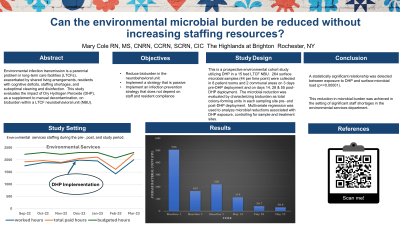Environment of Care
Category: Environment of Care
ePoster Kiosk Presentation
EOC 66 - Can the Environmental Microbial Burden Be Reduced Without Increasing Staffing Resources?
Monday, June 3, 2024
9:45 AM - 10:15 AM CST
Location: Kiosk 3 - APIC Central, Hall 1

Has Audio

Mary L. Cole, RN, MS, CNRN, CCRN, SCRN, CIC
Infection Control Specialist / Project Manager
The Highlands at Brighton
Presenter(s)
Disclosure(s):
Mary L. Cole, RN, MS, CNRN, CCRN, SCRN, CIC: Synexis: Consultant/Advisory Board (Ongoing), Other Research Support (Ongoing)
Background: Environmental infection transmission is a perennial problem in long term care facilities(LTCFs), exacerbated by shared living arrangements, residents with cognitive deficits, staffing shortages, and suboptimal cleaning and disinfection. This study evaluates the impact of dry hydrogen peroxide (DHP), as a supplement to manual decontamination, on bioburden within an LTCF neurobehavioral unit.
Methods: In this prospective environmental cohort study utilizing DHP in an LTCF's 15 bed neurobehavioral unit, 264 surface microbial samples (44 per time point) were collected in 8 patient rooms, 2 communal areas on 3 consecutive days pre-DHP deployment and on days 14, 28, and 55 post-DHP deployments. The microbial reduction was evaluated by characterizing bioburden as total colony-forming units in each sampling site pre- and post-DHP deployment. Volatile organic compound levels were also measured in each patient area on all sampling dates. Multivariate regression was used to analyze microbial reductions associated with DHP exposure, controlling for sample and treatment sites.
Results: A statistically significant relationship was detected between exposure to DHP and surface microbial load (P < 0.00001). Additionally, the average volatile organic compound level postintervention was significantly lower than baseline levels (P=0.0031).
Conclusions: DHP can significantly reduce surface bioburden in occupied spaces, potentially enhancing infection prevention and control efforts in LTCFs.
Learning Objectives:
- Upon completion, the learner will be able to verbalize an understanding of the infection control challenges in a long-term care unit with cognitively impaired residents.
- The learner will be able to compare and contrast covid outbreaks in a dry hydrogen environment versus a nontreated environment.
- The learner will be able to create a business plan for infection prevention versus infection response.

